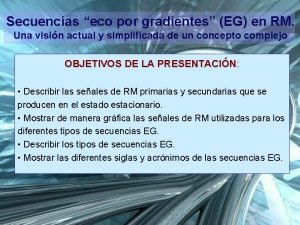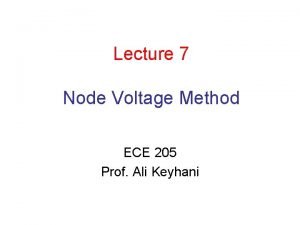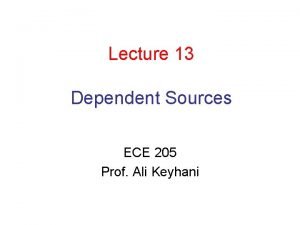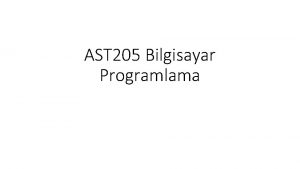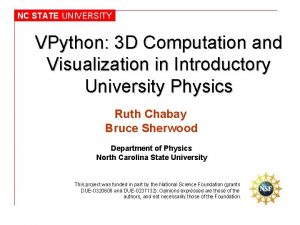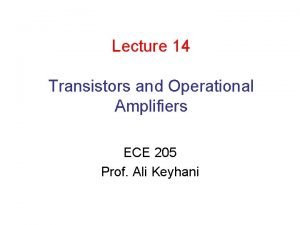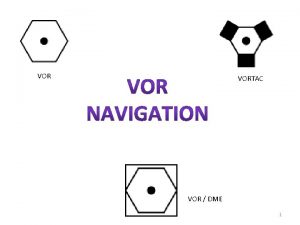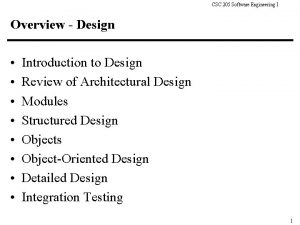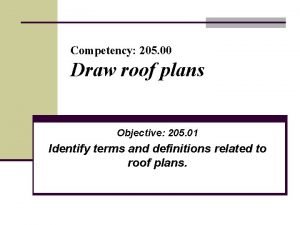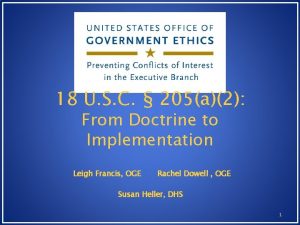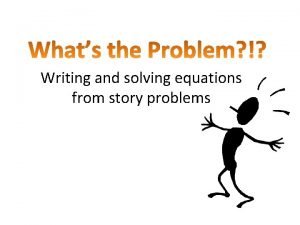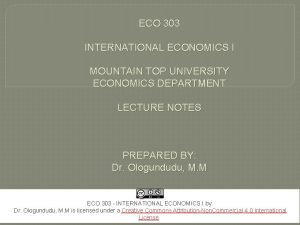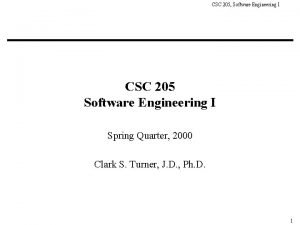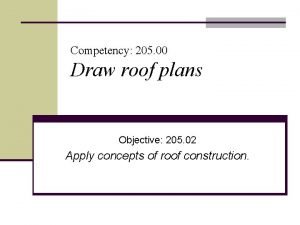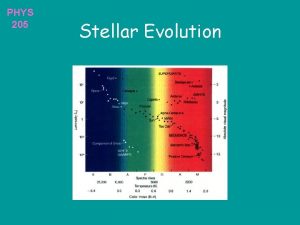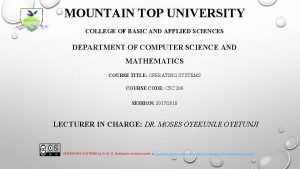Mountain Top University Department of Economics ECO 205



























- Slides: 27

Mountain Top University Department of Economics ECO 205: MATHEMATICS FOR ECONOMISTS I BY OLANIYI CLEMENT OLALEKAN Mathematics for Economists I by Olaniyi Clement Olalekan is licensed under a Creative Commons Attribution-Non Commercial 4. 0 International License.

Introduction This course is set aside to provide background for the importance of mathematics as a vital tool in the field of economics. The modern economics requires sound knowledge of mathematics. Better understanding is acquired when economic concepts and ideas are explained in mathematical language in order to ensure precision. Economics is a discipline which one cannot claim to be an expert without having adequate knowledge of basic mathematics. Thus, this course takes an important place in

Introduction (continues) criticized the uses of mathematics in economics yet this has not in any way diminished the significance of mathematics in economics. Mathematics for economists is subdivided into I and II. While the first aspect is covered in Mathematics for Economists I (ECO 205), the second aspect is to be covered in the second semester, Mathematics for Economists II (ECO 208). This course will not only be taught in abstracts but practical applications to the field of economics will also be adequately considered. The key to success in mathematics for economists is INTEREST. When you have interest

Mathematical economics is a discipline/aspect of economics that What is Mathematical Economics? utilizes mathematical principles and methods to explain economic theories and concepts, and to investigate economic phenomena. Mathematics permits economists to conduct quantifiable tests and create models to predict and forecast future economic activity. Thus, mathematical economics is the applications of

Importance of Mathematics in Economics It helps to explain interdependent relation between different variables. 2. It makes real life economic phenomena more understandable and logical with high level of precision 3. It makes economics to attain scientific respectability 4. It helps economists to assure security with respect to claims of truth 1.

Having discussed the importance of mathematical economics and what Mathematics for Economists is all about. The expected topics to be covered include the following 1)Series and Sequences; 2)Set theory and applications; 3)Calculus of functions of several variables with applications to optimization; 4)Partial Differentiation; 5)Lagrange Multiplier; and 6)Constrained Optimization in economics.

Series and Sequences

Each number in a sequence is called a “term” or an “element”. Also, a “series” is the value you get when you add up all the terms/elements of a sequence. There are two special types of sequence. Namely, Arithmetic Progression and Geometric Progression. These are explained in the subsequent sections

Arithmetic progressions

Class Examples on Arithmetic Progression

The Sum (S) of an AP

The Sum (S) of an AP (continues)

The Sum (S) of an AP (continues)

Class Examples on the Sum of an AP

A. Applied On commencing employment a man is paid a salary of Questions on Arithmetic Progression (AP) £ 7200 per annum and receives annual increments of £ 350. Determine his salary in the 9 th year and calculate the total he will have received in the first 12 years. [The Answers: £ 10, 000; £ 109 500] B. An oil company bores a hole 80 m deep. Estimate the cost of boring if the cost is £ 30 for drilling the first metre with an increase in cost of £ 2 per metre for each succeeding metre. [The Answer: £ 8720] C. An advertisement for an appointment states that the post carries a salary of £ 1200 per annum rising by annual

Geometric Progression

Class Examples on the Sum of an AP 1. 2. 3. 4. 5. Find the 10 th term of the series 5, 10, 20, 40, . . [The Answer: 2560] Determine the tenth term of the series 3, 6, 12, 24, . . . [The Answer: 1536] Which term of the series 3, 9, 27, . . . is 59 049? [The Answer: 10 th ] The first term of a geometric progression is 4 and the 6 th term is 128. Determine the 8 th and 11 th terms. [The Answers: 512, 4096] Find three numbers in geometric progression such that their sum is 19 and their product is 216. [The Answers: 9, 6, 4 OR 4, 6, 9

Class Examples on the Sum of an AP (continues)

The Sum of a GP

The Sum of a GP (continues)

Class Examples on Sum of a GP

Applied Questions on Geometric Progression

Differentiation of Function of One Variable

Rules of Differentiation of Explicit Function

Rules of Differentiation of Explicit Function (continues)

Rules of Differentiation of Explicit Function (continues)

Rules of Differentiation of Explicit Function (continues) Mathematics for Economists I by Olaniyi Clement Olalekan is licensed under a Creative Commons Attribution-Non Commercial 4. 0 International License.
 Eco 205
Eco 205 Epifid
Epifid Maastricht university school of business and economics
Maastricht university school of business and economics Mathematical economics vs non mathematical economics
Mathematical economics vs non mathematical economics Ar 623 3
Ar 623 3 205 binary
205 binary Types of ncoers
Types of ncoers Node voltage method
Node voltage method Node voltage analysis with dependent sources
Node voltage analysis with dependent sources Eet 205 syllabus
Eet 205 syllabus Ast 205
Ast 205 Sia 205
Sia 205 Phy 205
Phy 205 Nc state unity
Nc state unity Che 205
Che 205 Eet 205
Eet 205 Ece 205
Ece 205 205 lafayette street newark nj
205 lafayette street newark nj Item 205
Item 205 Vor/dme symbol
Vor/dme symbol Far91.205
Far91.205 346 rounded to the nearest hundred
346 rounded to the nearest hundred Modular decomposition in software engineering
Modular decomposition in software engineering Gable roof plan drawing
Gable roof plan drawing Far91.205
Far91.205 18 usc 205
18 usc 205 A race car can travel at a rate of 205 miles per hour
A race car can travel at a rate of 205 miles per hour A blue segmented circle on a sectional chart
A blue segmented circle on a sectional chart

